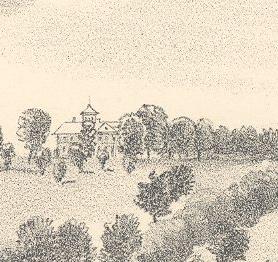The Ancient Unconsecrated Cemetery Plot Within Calvary – The Duryea House at Penny Bridge and the Military Outreage of 1779.
The recent destruction of the old Alsop house, built in 1651, on the shore of Newtown Creek, particulars of which were published in the Sunday Eagle of March 21, occasioned more interest and received more attention than usually attaches to ancient landmarks. Thomas Wandell, the founder of the Alsop family, died in the old house in 1691. The family burial ground was on the crown of a hill that formed part of the farm. It is there yet, though the farm has been absorbed by Calvary as an abode for the dead. The burial plot is within Calvary, but distinct from the consecrated area surrounding it, and there it will remain so long as Calvary exists, by special reservation in the deeds. Neglected is the grave of Thomas Wandell, no stone or other mark of affectionate remembrance denoting the tenant of nearly two centuries. In the same plot repose the remains of Richard Alsop, who succeeded to Wandell’s estate, being his nephew, and who died in 1718 aged 58 years; Richard Alsop, who died in 1764, aged 70 years; Richard Alsop, Jr. died in 1790 aged 60 years; John Alsop died in 1837 aged 58 years; Thomas Alsop died in 1857 aged 71 years; Susannah Brinckerhoff died in 1772; Annie Raymond 1859; Francis Whitehead, 1827; Elizabeth Fish, 1798; James A. Hildreth, 1648; Elizabeth A. Hildreth, 1811; Mary A. Hildreth, 1818; Hannah Hildreth, 1822; Patrick Hildreth, Master in Chancery, 1832; Elizabeth Van Dyke, 1847; Catherine Van Dyke, 1848; Catherine Alsop Van Dyke, 1847; Catherine Brinckerhoff Alsop, 1841; Thomas Edward Alsop, 1829; Richard Alsop, 1798; Elizabeth Alsop, 1794; Abigail Alsop, 1821; Thomas Alsop, 1779; Hannah Alsop, 1777; Richard Alsop, 1772; Richard Alsop, aged 1 month, no date; Elizabeth Alsop, 1776; Maria Knox, 1798; Hannah Alsop, wife of the first Richard, 1757 aged 91 years; Elizabeth Alsop, 1753. While Richard Alsop, the first, was a full fledged Englishman, his wife, Hannah, who survived him thirty-nine years, was a Hollander, and their courtship was conducted by a male interpreter. In 1776, the Alsop house was the abode of Lord Cornwallis, Colonel Meadows, Sir Henry Clinton and a retinue of military men of less repute. They slept there the night before the day of the capture of New York, and there is in the vicinity a great stone on which Cornwallis and Meadows stood on the eve of battle, exchanging ideas. That morning, the troops encamped on the Brinckerhoff, Morrell, Bragaw and Moore farms, broke camp and joined their comrades in the camp at Laurel Hill, and the cedar lots on the DeBevoise farm. Cornwallis gave a grand breakfast to his aides de camp, cooked on the great hearth in the Alsop mansion. Mrs. Alsop was an ardent Tory, and the generals and colonels paid her marks of great distinctions.
Richard Alsop was a patriot and made himself very conspicuous at the commencement of hostilities, but the occupation of his grounds by Colonel Ruggles and his little regiment for eight years, kept his spirit in complete subjection. His house, from its convenient position, became a sort of half way inn or military post between New York and Newtown. The naval guard boats on the creek were directly in front of it. Relays of horses were always in readiness for the quick dispatch of orders from one camp to another. Beside affording his house protection against the raids of the foraging hordes, Alsop realized great sums of money from the British exchequer. His neighbors were less fortunate. They were preyed upon and brutally treated by the soldiery, and robberies of were of almost nightly occurrence. Richard Alsop was Justice of the Peace, and one of the records which he made, and which is to be found in the archives of the town, is as follows:
“George and Peter Duryea, with their wives, Sarah and Catherine, being one family, doth make oath before Richard Alsop, Esq. of Newtown, that at nine o’clock in the evening of October 15th, 1779, for or five men disguised, meanly habited, with faces blackened, armed with a gun, bayonet fixed, a pistol, a number of clubs and a cutlass, forced in their house at Bushwick west side of the creek, and assaulted the inmates. George received four dangerous blows on his head, which settled him on the floor. Not quite deprived of reason, he crawled under a bed and laid still to avoid being murdered. Peter received six wounds about the head and one on his arm, but at length escaped and alarmed his neighbors. Meanwhile, the villains broke open two desks and a cupboard, and took two hundred pounds in good cash, all gold and silver, a pair of spoons marked, “G.D.,” a silver bowl and a pair of silver knee buckles marked, “P.D.” Previous to the robbery Catherine was seized by the throat, thrown on the floor and almost choked to death.”
The Duryea house, the scene of the above outrage, is still inhabited, and may be seen near the Penny Bridge. It is thought to be about a century and a half old. Some years since a silver spoon was found in the cellar. The initials showed it to be one of the lot stolen on that dreadful night in October, 1779. The old house is fast going to decay and will soon pass out of existence.



